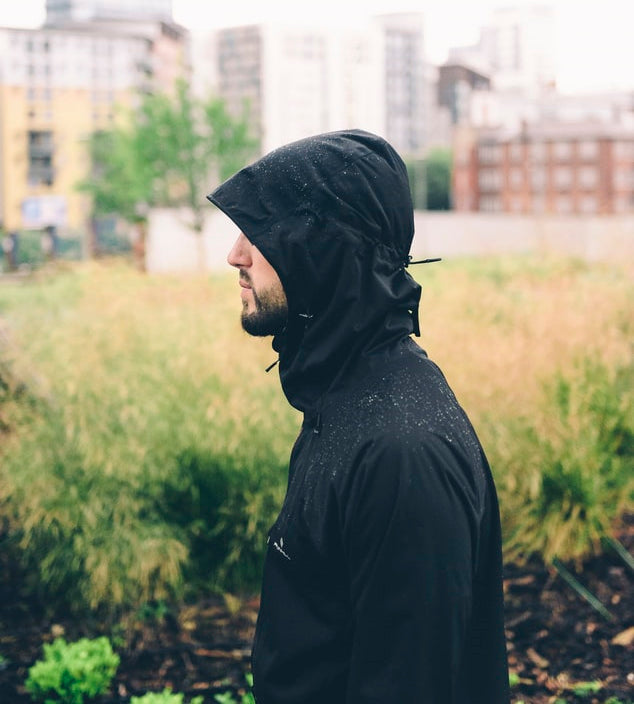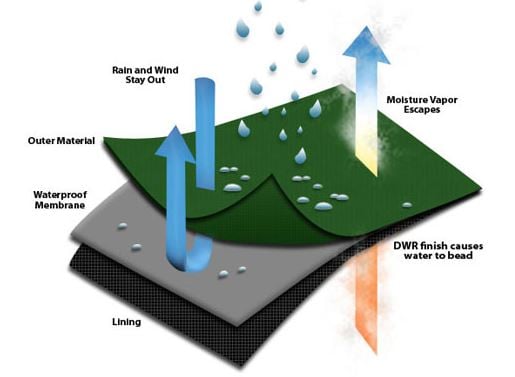Rain gear is an investment, plain and simple. If you take time to appreciate the technology involved, it’s pretty interesting stuff, and the investment seems worthy. Why are quality rain jackets so expensive? Let’s take a look.
First, please remember -- no fabric will keep you completely dry. A jacket made of solid rubber might, but the built-up moisture from your skin can't escape, and you'll begin to overheat and panic like Will Ferrell inside a glass case of emotion.
So while the rain won’t get you wet, your own perspiration will. That’s why breathability in waterproof fabrics is a major factor in deciding which rain jacket to purchase, based on your level of activity and the climates you’ll encounter along the way.
Thankfully, we have scientists for this kind of thing. Here are three ratings commonly used to measure how effective a fabric is at withstanding moisture, pressure, and breathability -- the best predictors for a high-performance rain jacket.
Rating Systems Explained -- get ready for some science!
Moisture (mm/24) : how many millimeters of water the fabric can withstand in 24 hours
Pressure (psi) : how many pounds per square inch the fabric can withstand when it’s wet
Breathability (g/m²/24) : how many grams of water vapor pass through the fabric in 24 hours
How do you choose which rating to pay attention to? Consider these scenarios:
If you’re buying a jacket for leisure hiking or jogging in the rain, the breathability rating is good to use, since you’ll be at a higher level of activity for a sustained period of time, and don't want sweat to build up inside your coat.
If you shred heavy in snow sports, you’ll want to focus on the moisture rating, since being on the mountain is an all-day affair, and falling snow produces a lot of cold, wet moisture. If you’re a novice skier or snowboarder, check out the pressure rating too, since many forceful contacts with the snow yields greater permeability in the fabric.
If you’re backpacking in wet conditions, you'll want to focus on the moisture and pressure rating, as the pack creates extra friction along the back and shoulders, making the garment more permeable.
Each scenario would benefit from a high breathability rating. The only time you’d want less breathability is in cold, dry climates. In these environments, your body heat stays inside the jacket and keeps you warm without producing excess moisture.
Since manufacturers use their own methods as well as independent labs for testing, truly standardized ratings can be hard for consumers to find. Because of this, it’s more effective to compare within a brand, or within the same group of fabrics, than compare different brands to each other. However, if you pinpoint a range within each rating that is best suited for your activity and climate (look to brand websites), this will generally be a good predictor for which fabric will provide the best bang for your buck.

Multi-Point Adjustable Hoods offer extra weather protection
Photo by Stephen Arnold on Unsplash
DWR (Durable Water Repellent)
DWR is an easy, moderately-priced solution for getting caught in drizzling rain or snow. It's a common feature on "softshell" jackets. While it's not waterproof, it still allows moisture to bead up and slide down the fabric while maintaining a high breathability rating. The effectiveness of the manufacturer’s DWR treatment diminishes, however, the more you expose it to inclement weather, dirt, and friction.
Not to worry! You can apply DWR treatments at home, or even while on the trail. These low-cost solutions are a must for preserving the water-repellency of your jackets, shoes, and tents. Always wash and fully rinse your gear before applying these treatments, so dirt and oils won’t lock in and hinder the effectiveness of the treatment. Check out these Waterproof and DWR sprays and fabric washes that are simple, effective, and super easy to use.
GORE-TEX
This proprietary product from the W.L. Gore Corporation is a top-selling feature for waterproof jackets and footwear. It uses a membrane (instead of an outer coating) that is laminated to nylon and polyester face fabrics to create a highly waterproof, somewhat breathable barrier. GORE-TEX utilizes billions of microscopic pores to create different grades of protection, so you can spend money only on the barrier thickness you need.
The thing with GORE-TEX is, it’s waterproof, so you’ll want to be careful how long you keep these garments on. If you plan to wear GORE-TEX fabrics continuously for days on end, do so only in cold, dry conditions. Wearing GORE-TEX in warmer, more humid weather for extended periods of time could cause potential skin issues from prolonged exposure to moisture.
Taped/Sealed Seams
Needle stitching pokes thousands of tiny holes in your gear, so most outerwear worth their more expensive pricetag has a thin layer of waterproof tape over the top of the stitching to prevent water from trickling in. Without seam sealing, you’ll get wet no matter how waterproof your fabrics are. Some garments utilize seam sealing only in the most critical areas, like the neck, chest, and shoulders, while others boast “fully sealed seams.”
Pit Zips
If you need to sacrifice breathability for a better moisture rating (a common forfeiture, for better or worse), make sure your jacket is equipped with zippers under the arms. These allow body heat to escape from critical areas without you having to unzip the main zipper or remove the jacket entirely. These help tremendously when going from no activity to lots of activity in a short period of time.
YKK & Waterproof Zippers
Back to that glass case of emotion: faulty zippers provide a general feeling of wanting to give up, on everything. YKK is the most reliable zipper system on the market, ensuring a smooth zip every time. Waterproof zippers are something else to consider, but come with mixed reviews. They can be hard to operate, especially larger ones coated with urethane. YKK offers waterproof/water-resistant zipper options that work well, as does Riri, another favored brand. Another option is a storm flap -- if engineered with a no-snag design -- that covers the top of your zipper system with a long strip of waterproof or water-resistant fabric.

To see which jackets and features work best for you, browse our selection of:
- Women's Rain Jackets
- Women's Insulated Rain Jackets
- Men's Rain Jackets
- Men's Insulated Rain Jackets
- Kid's Rain and Insulated Jackets
And remember, the best waterproof-breathable membrane is your very own skin!
Written by Lindsay McDuffie for MountainHighOutfitters.com
Cover Photo by Taneli Lahtinen on Unsplash



